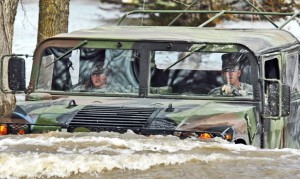
Severe flood episodes have plagued the US Midwest over the past 50 years, but they haven’t increased in severity—just in number.
The findings, based on daily records collected by the US Geological Survey at 774 stream gauges in 14 states from 1962-2011, show that 264 (34 percent) of the stations had an increase in frequency in the number of flood events. Only 66 stations (nine percent) showed a decrease.
“It’s not that big floods are getting bigger, but that we have been experiencing a larger number of big floods,” says Gabriele Villarini, assistant professor of civil and environmental engineering at University of Iowa.
Rainfall and Temperature
The findings likely come as no surprise to millions of people in the Midwest and bordering states. During the past several decades, large floods have plagued the region in 1993, 2008, 2011, 2013, and again in 2014,which have caused agricultural and economic losses in the billions of dollars, displaced people, and led to deaths.
“There is a pattern with increasing frequency of flood events from North Dakota south to Iowa and Missouri and east into Illinois, Indiana, and Ohio,” says Iman Mallakpour, a graduate student in civil and environmental engineering and lead author of the paper that is published in Nature Climate Change.
“We related this increasing number of big floods to changes in rainfall and temperature. There was an overall good match between the areas with increasing frequency of flood events and areas experiencing increasing frequency of heavy rainfall events,” Villarini says.
Seasonal analysis revealed that most of the flood peaks in the upper Midwest occur in the spring and stem primarily from snow melt, rain falling on frozen ground and rain-on-snow events.
Interestingly, spring—in addition to being a season with increasing frequency of heavy rainfall—also has the strongest increase in temperature over most of the northern part of the region studied.
The findings jibe well with current thinking among climate scientists about how the hydrological cycle is being affected by global warming. In general, as the atmosphere becomes warmer, it can hold more moisture. One consequence of higher water vapor concentrations is more frequent, intense precipitation.
The current study doesn’t attempt to link the increase in the number of episodes to climate change.
“What causes the observed changes in precipitation and temperature is not something we have addressed because of the difficulties in doing so just based on observational records,” Villarini says.
The study region included: Iowa, Illinois, Indiana, Wisconsin, Ohio, Michigan, Minnesota, Kansas, Nebraska, Missouri, West Virginia, Kentucky, North Dakota, and South Dakota.
Researchers established a threshold level of two flood events per year, on average, for each of the 774 stream gauges. In order to avoid counting the same event twice, the researchers recorded only one event within a 15-day period.
The US Army Corps of Engineers Institute for Water Resources, the Iowa Flood Center, the National Science Foundation, and IIHR-Hydroscience & Engineering funded the work.
Source: University of Iowa




